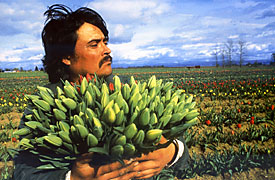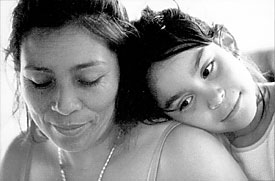 |
|
Courtesy of the Center for Creative photography
|
Luis Entrada, a migrant worker, carries tulips through a field in Woodburn, Oregon. This photograph, taken by Timothy González, is part of the "Americanos" exhibit currently on display at the Center for Creative Photography. The exhibit runs now through March 2.
|
|
By Lindsay Utz
Arizona Daily Wildcat
Thursday January 16, 2003
"Americanos" aims for accurate portrayal of Latinos' diverse roles in the United States
A woman stands in a shadow behind a fence lined with colorful brooms, brooms that she has sold outside her Los Angeles home for nearly twenty years. She's a single face belonging to a community of faces, one story belonging to a larger story. It's a story that lifts the shadow off Latino culture, bringing into focus a community that embodies the American spirit.
That photograph is just one of many currently on display at the Center for Creative Photography. "Americanos" is a vibrant look at contemporary Latino culture in the United States.
Perhaps an exhibit that takes on more significance in the context of our close geography to Mexico and the continuous, bold reminder of the border that separates "us" from "them." But to say this is exclusively a Southwestern, a Mexican or even a South American exhibit is flawed. "Americanos" is, above all else, an American exhibit.
The project started more than eight years ago when photographer Manuel Monterrey went to actor and activist Edward James Olmos with the idea. Bringing together the work of thirty top Latino photojournalists, including Tucson native José Galvez, and the writings of such prominent figures as Carlos Fuentes and Maya Angelou, "Americanos" is a celebration of Latino life in the United States.
After five editors went through some 50,000 photographs, they narrowed it down to the 120 photographs, both color and black and white, which now make up the show. It has been traveling the country since 1998, when it opened at the Smithsonian Institution.
The photos cover a wide range of Latino communities ų people from New York to Chicago to Los Angeles and everywhere in between. The photos serve as reminders of the rich cultural fusion that makes America one of the most unique countries in the world.
 |
|
Courtesy of Center for Creative Photography
|
Creators hope that photos such as Nuri Vallbona's depiction of a mother and her daughter in South Dade, Florida will educate the public about how Latinos live in the United States.
|
|
People have their own ideas and preconceptions about the word "Latino." It's easy to associate the word with Mexico, maracas, mariachi and merengue.
"You have to get rid of that misconception that we're all from Mexico, or our parents or our grandparents are all from Mexico," Galvez said.
Too often, we look at Latinos not as Americans but as strangers to this land. But the truth is that they are a very proud and diverse population, one that is just as American as any. They helped build this country from the ground up and contributed to the thriving success it has attained today.
Galvez, who was one of the contributing editors to the exhibition and its book, believes that documentary photography has the power to raise social awareness and educate the community.
"I hope for the person who is not aware of our contribution to the American society, that they'll see that we're more than just farm workers or working at the car wash," he said. "We're more than people coming across the border looking for jobs."
Check it out
What: Community Day Celebration
When: 1 ų 4 p.m. Jan. 18
|
Cass Fey, curator of education at the Center of Creative Photography admitted, "We're rife with misconceptions. That's who we are."
But she also believes that history proves documentary photography has been used as a tool for social change.
"This particular documentary exhibition is about Latinos helping to define themselves for the rest of the world," she said. "It's a self-portrait in that the 30 photographers are all Latino, and were assigned to go out and document their people, their community. That's a very powerful voice."
"Americanos" is a very political exhibit in that it clearly wants to break down stereotypes, educate the public and bring to light the important roles of Latinos all over the United States.
"We're all Americans. We're doctors, we're lawyers, we're students, we're farm workers, we're cowboys, we're little grandmothers, we're little kids on the swim team," Galvez said.
 |
|
Courtesy of the Center for Creative Photography
|
This photograph of a family deciding what to order at Pat's Drive-In Diner by fine arts graduate student Michael Gonzáles is included in a slide presentation at the CCP. Gonzáles has taken a series of photographs of the popular Tucson restaurant.
|
|
Ultimately, beyond the political agenda of this show, its influential nature comes mostly from the power of the actual images. The color photographs are sizzling with life and energy, while the black and white images are more emotionally driven.
Galvez fought hard for more black and white photos and less color while working with the four other editors in choosing the photographs.
"Color says different things to the viewer than black and white does. You look at color and say what a pretty picture," he said. "Black and white really works on your emotions much more than color does."
While he didn't win the fight, his point is valid. Black and white photography does seem to hold the viewer's gaze a little bit longer. It's because you have to search for the color in the gray zone. The meaning is soft-spoken, hidden within the grains of the image.
There is a small series of photos by photojournalist Janet Jarman in which she follows Marisol, a young Latina, as she and her family emigrate from Mexico to Florida and then to Texas. In a breathtaking black and white portrait of Marisol, her hair windswept from her face, her skin dark in the sun's rays, her eyes clear and white looking off into the distance, there is depth. In her face we see the dreams, desires and despairs of all Latinos struggling, like all other Americans, to make better lives for themselves.
Check it out
· José Galvez will discuss his works with "Americanos" on February 18, 5:30PM.
· Michael Gonzáles will discuss his project "Transcending Time and Culture in Barrio Hollywood" on Wednesday, January 22, at 5:30PM.
Check CCP out online: www.creativephotography.org
|
To accompany the exhibition the CCP has put together a series of programs that also deal with Latino culture in the United States. Of particular interest is one artist's talk and slide presentation of a project he's currently working on. His name is Michael Gonzáles, and he is a graduate student in the fine arts department.
After he graduated from college with a degree in engineering, Gonzáles' mother gave him a camera as a gift. Until then, he had never taken a picture. When his passion for photography overwhelmed his interest in engineering, he decided to go back to school and pursue his newly-discovered talent.
In coming here, he stumbled upon an old diner in a predominately Hispanic west Tucson neighborhood known as Barrio Hollywood. Pat's Drive-In Diner is a Tucson gem with doors that have been open for nearly 40 years now. Fascinated, he's made it his job to capture the essence, flavor and culture surrounding this very significant community restaurant.
"This place holds a special spot in the neighborhood because of its longevity but also because of the environment it provides," he said. "It is a really unique social space."
There's a really classic feel about Pat's Drive-In Diner, as if when you pull up to eat there you're whisked back 40 years to a time and place a little more personal and a lot less harsh than today's fast-moving society. Women gossip and reminisce about their younger days, teenagers come to be seen, and for the little child it is a playground of lights and life.
"To me, as an artist, something magical that happens at night when you get a large number of old cars come in and you watch people ordering," he said. "I start thinking that this is as close as I'm going to ever get to knowing what it would've felt like in the sixties. I really think this place transforms for me at night."
Gonzáles has a conflict with the exact nature of his project:: Is it documentary photography or fine art? A little of each, both capturing a moment and painting a portrait of an important Tucson eatery, an important body of work that's both appreciated by the people in the community and admired as a work of art that will endure throughout the years ahead.
"Even as a fine arts photograph, what I can capture is a Hispanic business run by Hispanic employees that are running a business that is really an icon of Tucson," he said. "That I can capture images of this place will present this Hispanic community in a favorable light, demonstrating that these are hardworking people, who are able to run a successful business for forty years."
When Charlie Hernandez, current owner of Pat's, goes with his family to see Gonzáles' presentation, he'll be proud. He'll be proud just like Latinos and others can be proud of the "Americanos" exhibit.
"We've had a lot of families come in, in particular Latino families," said Fey. "Just coming in and looking and talking and seeing something of themselves in there is really quite nice."

